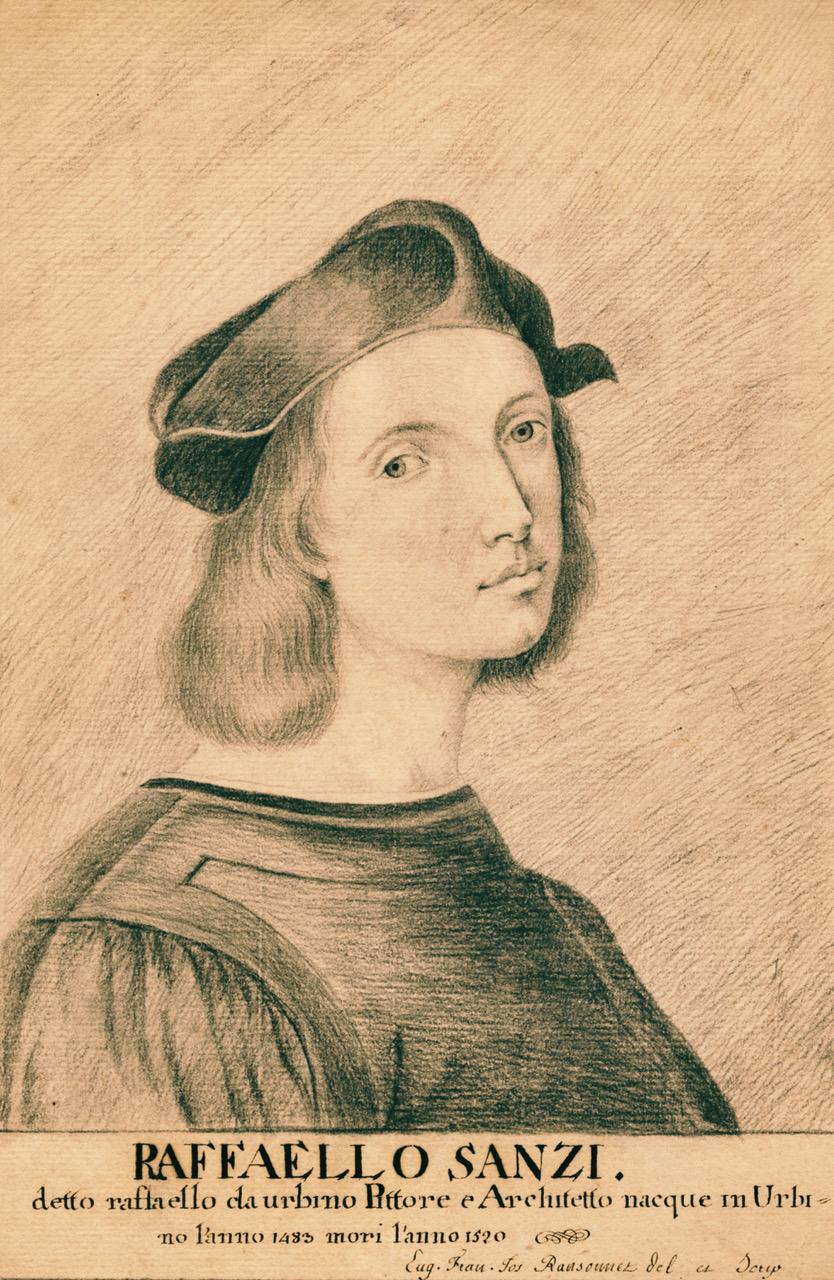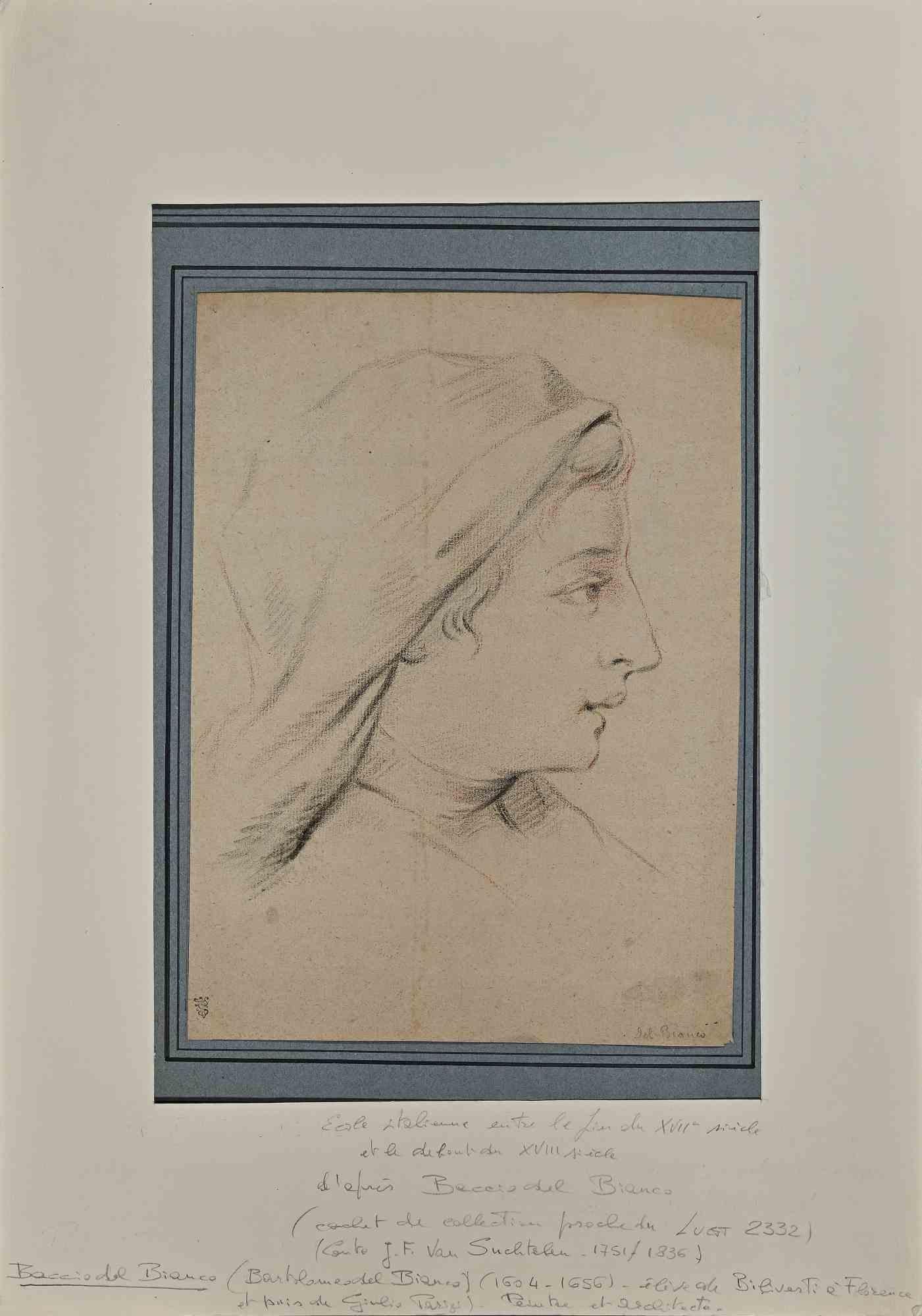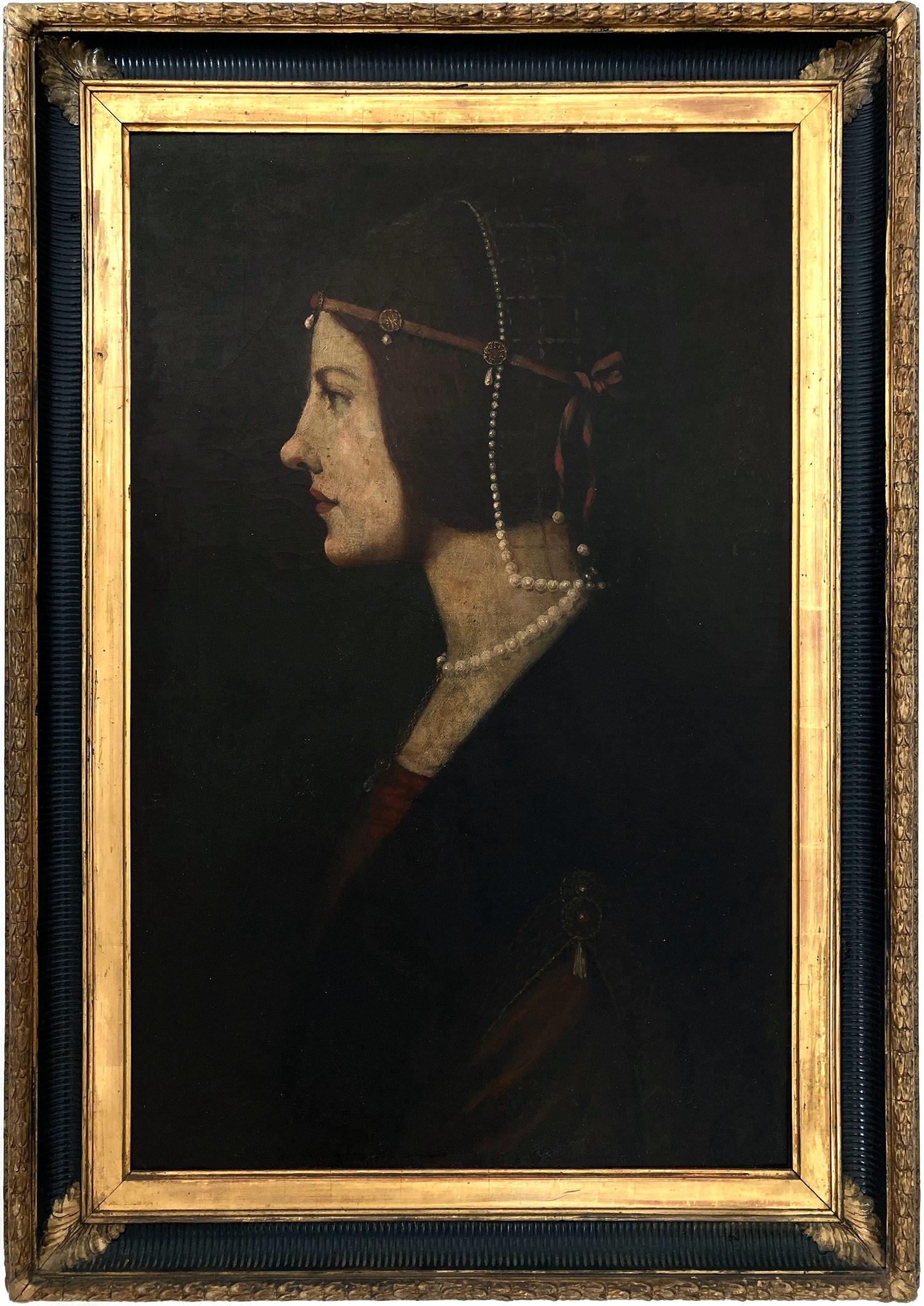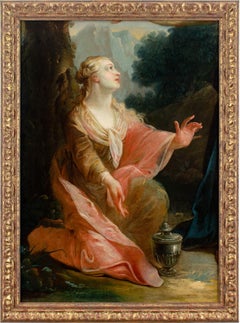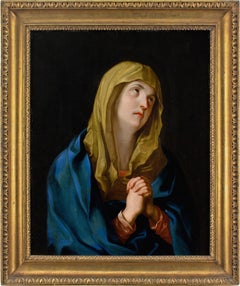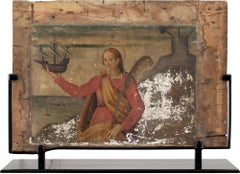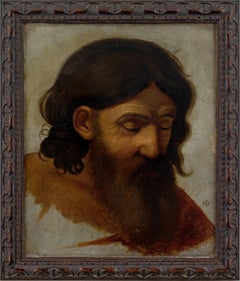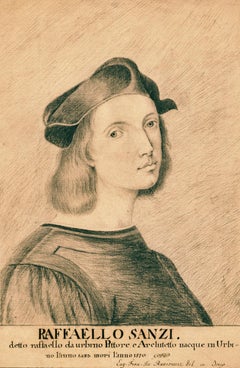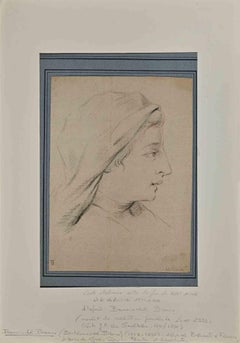Items Similar to Girolamo Tubino After Raffaello, Sanzio Da Urbino La Velata
Video Loading
Want more images or videos?
Request additional images or videos from the seller
1 of 14
Girolamo TubinoGirolamo Tubino After Raffaello, Sanzio Da Urbino La Velatac. 1840
c. 1840
$1,945.94
£1,430
€1,680.01
CA$2,673.39
A$2,984.58
CHF 1,563.88
MX$36,534.24
NOK 19,861.25
SEK 18,726.64
DKK 12,538.11
Shipping
Retrieving quote...The 1stDibs Promise:
Authenticity Guarantee,
Money-Back Guarantee,
24-Hour Cancellation
About the Item
This fine mid-19th-century watercolour by Italian artist Girolamo Tubino (1805-1879) is after ‘La Velata’ (Woman with a Veil) by Raphael (1483-1520), which is housed at the Palazzo Pitti in Florence.
Raphael’s sumptuous depiction of this young married noblewoman captures beauty personified wrapped in exquisite cascading drapery. Her right hand is pressed to her heart in a romantic gesture of love, while her left arm is held forward to emphasise the decadence of her gown. Produced at the peak of Rapheal’s career, it represents one of his most enchanting portrayals.
Copied by Girolamo Tubino in around 1840, this sublime homage respectfully conveys the allure of the original. Tubino was one of the leading copyists of his generation and worked closely with the Uffizi Gallery.
Born in Genoa, he undertook his training at the prestigious, and remarkably formal, Academy of Fine Arts in Florence. By today’s standards, it’s impossible to imagine the respect his tutors afforded to the Old Masters and students were expected to laboriously study models from antiquity to hone their drawing prowess. Many would be daunted by the reverence given to Italy’s rich artistic heritage, but Tubino was altogether different. Rather than cower in the wake of such luminaries, he embraced them, inspired by the possibilities.
He frequented numerous galleries during his time in Florence and produced an array of drawings after numerous masterpieces. Many of these were designed ahead of lithographs of which several are held at the British Museum. They include works after Titian, Annibale Carracci, Carlo Dolci and Andrea del Sarto among others. In addition, he also produced drawings of Raphael’s ‘Madonna del Cardellino’ and ‘Ezekiel's Vision’.
In 1851, he was appointed a teacher at the Accademia Ligustica di Belle Arti di Genova, where he later became its chair of drawing. He also began exhibiting in his hometown at the Società Promotrice di Belle Arti.
In the memoirs of the Honourable William Warren Vernon, a scholar, he recalls being given a splendid tour of Genoa by Tubino, which included “all the palaces, galleries, churches, and other sights”. Vernon was so taken with some of the masterpieces on display that he “commissioned Tubino to make us copies in water-colour of two beautiful boys by Vandyck”.
Throughout his remarkable career, he maintained the glowing respect of his peers and students alike, with many training under him via the Academy. The press, too, were in raptures with one critic praising his “beautiful smoothness of execution”.
He’s represented in several public collections including the British Museum and Genoa’s Galleria d'Arte Moderna.
Signed in gold lower right and housed within a period gilt frame.
Labels & Inscriptions: Label from art dealership P & D Colnaghi & Co.
Provenance: With P & D Colnaghi & Co / Private collection, UK.
- Creator:Girolamo Tubino (1805 - 1879, Italian)
- Creation Year:c. 1840
- Dimensions:Height: 16 in (40.64 cm)Width: 13 in (33.02 cm)
- Medium:
- Movement & Style:
- Period:
- Condition:Very good. Frame in reasonable condition with minor age-related wear.
- Gallery Location:Cheltenham, GB
- Reference Number:1stDibs: LU2328215427412
About the Seller
5.0
Platinum Seller
Premium sellers with a 4.7+ rating and 24-hour response times
Established in 2017
1stDibs seller since 2023
241 sales on 1stDibs
Typical response time: 1 hour
- ShippingRetrieving quote...Shipping from: Cheltenham, United Kingdom
- Return Policy
Authenticity Guarantee
In the unlikely event there’s an issue with an item’s authenticity, contact us within 1 year for a full refund. DetailsMoney-Back Guarantee
If your item is not as described, is damaged in transit, or does not arrive, contact us within 7 days for a full refund. Details24-Hour Cancellation
You have a 24-hour grace period in which to reconsider your purchase, with no questions asked.Vetted Professional Sellers
Our world-class sellers must adhere to strict standards for service and quality, maintaining the integrity of our listings.Price-Match Guarantee
If you find that a seller listed the same item for a lower price elsewhere, we’ll match it.Trusted Global Delivery
Our best-in-class carrier network provides specialized shipping options worldwide, including custom delivery.More From This Seller
View All18th-Century Venetian School, Mary Magdalene, Noli Me Tangere
Located in Cheltenham, GB
This late 18th-century Italian oil painting fragment depicts Mary Magdalene kneeling alongside an alabaster jar. Christ’s hand is partially visible above, along with his robes, which...
Category
18th Century Italian School Figurative Paintings
Materials
Oil, Canvas
Joszef Schmidt, After Guido Reni Mater Dolorosa, Antique Oil Painting
Located in Cheltenham, GB
This early 19th-century oil painting by Hungarian artist Joszef Schmidt (1810-1875) depicts the Mater Dolorosa. It’s after a work by Italian artist, Guido Reni (1575-1642). Schmidt w...
Category
Early 19th Century Italian School Figurative Paintings
Materials
Panel, Oil
Late 16th-Century Catalan School, Saint Madrona Of Thessalonica
Located in Cheltenham, GB
This remarkable late 16th-century fragment depicts Saint Madrona, the Patron Saint of Barcelona, Spain, holding a 15th-century carrack and the martyr’s palm frond. She stands before ...
Category
16th Century Figurative Paintings
Materials
Metal
Late 19th-Century French School, Head Study
Located in Cheltenham, GB
This enchanting late 19th-century French oil painting depicts the head of a bearded man.
Rendered with an abundance of consideration and feeling, the introspection of the figure po...
Category
1890s French School Portrait Paintings
Materials
Canvas, Oil
Mid-19th-Century German School, Portrait Of A Woman
Located in Cheltenham, GB
This fine mid-19th-century German miniature depicts a woman wearing a black dress and a beautiful white and lilac day cap.
Produced around 1840, this exquisite piece on porcelain is...
Category
1840s Victorian Portrait Paintings
Materials
Porcelain
Late 17th-Century Italian School, Architectural Capriccio With Portico
Located in Cheltenham, GB
This late 17th-century Italian oil painting depicts a view with distinctive Italianate architecture including a building with an iconic portico and pediment.
Popular in mid-17th-cen...
Category
1680s Italian School Landscape Paintings
Materials
Oil, Canvas
You May Also Like
XVII secolo, da Raffaello Sanzio (Urbino, 1483 – Roma, 1520), Madonna
By (after) Raphael (Raffaello Sanzio da Urbino)
Located in Milan, IT
XVII secolo, da Raffaello Sanzio (Urbino, 1483 – Roma, 1520)
Madonna con il Bambino
Olio su tela, cm 87x70
Con cornice, cm 113x96
Il dipinto in questione riprende il gruppo centr...
Category
19th Century Other Art Style Figurative Paintings
Materials
Canvas, Oil
Portrait of Raffaello / Italian School
Located in Middletown, NY
Graphite and ink on handmade, watermarked C & I Honig laid paper, 8 15/16 x 6 3/4 inches (226 x 170 mm). Signed illegibly in ink, lower margin. Scattered light creasing and surface...
Category
18th Century Italian School Portrait Drawings and Watercolors
Materials
Handmade Paper, Ink, Graphite
Portrait - Drawing after Baccio del Bianco - 17th Century
Located in Roma, IT
Portrait is a Pencil Drawing realized by an Italian artist of 17th and early 18th century, after Baccio del Bianco (1604-1656).
Good condition on a yellowed paper included a blue an...
Category
17th Century Modern Portrait Drawings and Watercolors
Materials
Pencil
Dipinto ritratto femminile figurativo barocco emiliano del XVII secolo
By Girolamo Negri called Il Boccia
Located in Florence, IT
olio su tela, 62 x 51 cm (senza cornice)
Il dipinto è stato per lungo attribuito alla mano di Francesco Gessi, allievo di Guido Reni, come riporta un'iscrizione a matita datata 1945...
Category
Late 17th Century Baroque Figurative Paintings
Materials
Canvas, Oil
Venetian school, 18th century, Portrait of a gentlewoman with a fan
By Tiziano Vecellio (Pieve di Cadore 1490 - Venice 1576)
Located in Milan, IT
Venetian school, 18th century
Portrait of a gentlewoman with a fan
Oil on canvas, 79 x 60 cm
Framed, 92 x 74 cm
Unsigned work
The oil on canvas under consideration, to be referr...
Category
18th Century and Earlier Other Art Style Portrait Paintings
Materials
Canvas, Oil
Copy of "Portrait of Beatrice dʼEste" by Leonardo da Vinci created 15th Century
Located in New York, NY
A masterful copy by an unknown artist, after the portrait of "Beatrice d'Este" by Leonardo Da Vinci also known as ‘Portrait of a Lady’ or ‘La Dama con la reticella di perle (The Lady With a Pearl Hairnet)’. The original work originally created in the 15th Century is currently on display in the Pinacoteca Ambrosiana Museum of Milan. Beatrice d'Este was the Duchess of Bari/Milan and was believed to be one of the most attractive princesses of the Renaissance. Her impeccable style won her many admirers throughout Italy and France, and she became a trendsetter of the highest order. This copy of the original painting, is an oil on canvas done in the 18th Century, and in this exquisite portrait, the artist has masterfully depicted the fine details with draped hair, pearls, royal dress, ornate headgear and sumptuous jewelry in front of a dark background. Once again, capturing the imagination with another enigmatic smile. It comes housed in an elegant period giltwood frame with ebonized trims and ready to be displayed with hanging wire on verso.
Art measures 28 x 18 inches
Frame measures 34.5 x 24.5 inches
There is much debate and controversy over who actually painted the "Beatrice d'Este" was it Leonardo da Vinci (1452–1519), or Giovanni Ambrogio de Predis (1455–1508). So we may never know who executed the original portrait which hangs in the museum, but that need not deter from an appreciation of its singularity. Following the portraiture convention established by painters of the Quattrocentro, the artist has chosen to portray his sitter in profile. In doing so, he magnificently captures the essence of his sitter, a girl on the threshold of womanhood. Bedecked in the adornments—silk, velvet, pearls and embroidery (brocade) crafted of spun gold threads—afforded her by birthright and marriage, Beatrice looks forward in noble serenity. And at the same time her profile with its upturned nose and slight smile betrays an innocence that must have been the basis of the oft-repeated epithet: la più zentil donna in Italia” (“the sweetest lady in Italy”).
It is believed the lady is Beatrice d'Este (1475-1497), duchess of Bari and later of Milan, the wife of Ludovico Sforza (known as "il Moro"). One of the most beautiful princesses of the Italian Renaissance, she was known for her good taste in fashion. Beatrice was a member of the Este-Sforza family, which joined by marriage two of the oldest reigning and already powerful houses in Italy. The house of Este, which held court in Ferrara, traced its lineage to the 11th century Dukes of Saxony and Bavaria. Beatriceʼs father, Ercole I ruled the Ferrara commune for 34 years, catapulting the city-state (and the Estes with it) to an unmatched level of economic prosperity and cultural prominence. The family was renowned for its love of letters and patronage of the arts.
The first time Leonardo da Vinci’s name resounded in the Ambrosiana, it was through the pen of its founder, Cardinal Federico Borromeo, who attributed this little panel to the great Master, describing it as “A portrait of a Duchess of Milan, by the hand of Leonardo”. Following the Cardinal’s statement, the portrait was for long assumed to depict Beatrice d’Este, the wife of Ludovico il Moro. However, scholars have recently been more cautious and vague in their statements, with regard to both the artist (anonymous Lombard or Emilian...
Category
18th Century Northern Renaissance Portrait Paintings
Materials
Canvas, Oil
More Ways To Browse
Old Master Italian Drawings
Antique Paper Press
Woman With A Veil
Uffizi Gallery
Genoa Italy Painting
Pitti Palace
Antique Church Chairs
William Artis
Annibale Carracci
Andrea Del Sarto
Carlo Dolci
Warren Chair Works
Oil Paintings Of Homes
Acrylic Nature Painting
California Landscapes
All Flower Art
Water Light
New England Art
